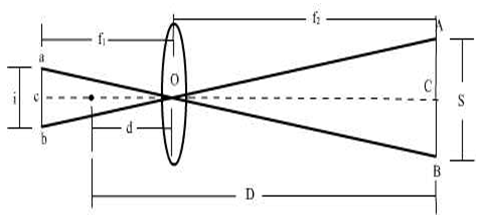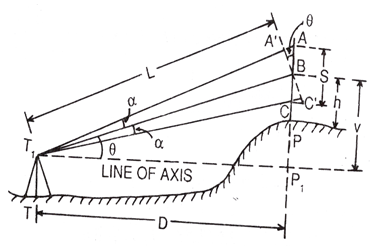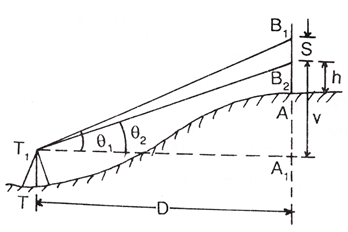This set of Surveying Multiple Choice Questions & Answers (MCQs) focuses on “Levelling – Stadia Method”.
1. Stadia method is based on the principle that ratio of perpendicular to the base is constant.
a) True
b) False
View Answer
Explanation: In isosceles triangle ratio to the perpendicular to the base is constant. Thus, this method principle is used in stadia method.
2. In stadia method, diaphragm in tachometer is provided with there stadia hairs and stadia hair reading is taken by looking through a diaphragm.
a) True
b) False
View Answer
Explanation: In stadia method, diaphragm in tachometer is provided with there stadia hairs and stadia hair reading is taken by looking through a telescope.
4. Difference between upper and lower stadia reading gives __________
a) stadia slope
b) stadia coordinate
c) stadia intercept
d) stadia size
View Answer
Explanation: Difference between upper and lower stadia reading gives stadia intercept. Stadia hair reading is taken by looking through a telescope.
5. In the below figure, f1/f2 = _______

a) i/s
b) s/i
c) D/d
d) d/D
View Answer
Explanation: From figure, aOA and bOB passing through optical center. So, ∆ aOb and ∆ AOB are similar triangles, then f1/f2= s/i.
6. From the following figure, D is?

a) kS+c
b) S + kc
c) k(S+c)
d) k S – c
View Answer
Explanation: Horizontal distance between the axis and staff is D = f1 + d = f*s/i + (f+d) = k.s+c, Where, D=k. s+c is distance equation, c is additive constant of instrument, k is multiplying constant or stadia interval factor.
7. In the following figure, D = k S + c, where k is additive constant.

a) True
b) False
View Answer
Explanation: Horizontal distance between the axis and staff is D = f1 + d = f*s/i + (f+d) = k.s + c, Where, D=k. s+c is distance equation, c is additive constant of instrument, k is multiplying constant or stadia interval factor.
8. In the following figure, D = k S + c, where c is additive constant.

a) True
b) False
View Answer
Explanation: Horizontal distance between the axis and staff is D = f1 + d = f*s/i + (f+d) = k.s + c, Where, D=k. s+c is distance equation, c is additive constant of instrument, k is multiplying constant or stadia interval factor.
9. In the following figure, D = ______

a) ks cosθ2 + ccosθ
b) ks cos2θ + ccosθ
c) ks cos2θ + ccos2θ
d) ks cos2θ + ccos2θ
View Answer
Explanation: Considering Angle of Elevation (positive), Here, A’C’ = Scosθ, T1B = L = KA’C’ + C
= kscosθ +c, D = Lcosθ = (kscosθ+C)cosθ, D = kscosθ2 + ccosθ.
10. In the following figure, D = __________

a) D = 2S/(tanθ1 – tanθ2)
b) D = 3S/(tanθ1 – tanθ2)
c) D = S/2(tanθ1 – tanθ2)
d) D = S/(tanθ1 – tanθ2)
View Answer
Explanation: Here, V+S = Dtanθ1, V = Dtanθ2, S = D(tanθ1 – tanθ2). Therefore, D = S/(tanθ1 – tanθ2).
Sanfoundry Global Education & Learning Series – Surveying.
To practice all areas of Surveying, here is complete set of 1000+ Multiple Choice Questions and Answers.
If you find a mistake in question / option / answer, kindly take a screenshot and email to [email protected]
- Check Surveying Books
- Practice Civil Engineering MCQs
- Apply for Civil Engineering Internship
- Check Civil Engineering Books
